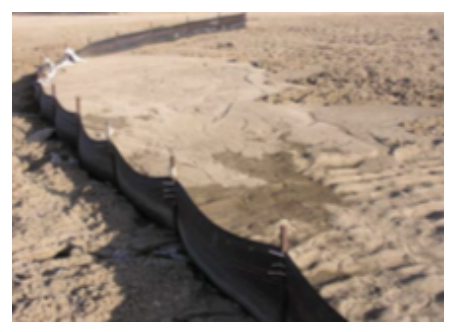Erosion Control
New ResidentialWhat is Erosion Control?
Erosion control refers to specific techniques employed during construction to help protect natural resources on a project site and adjacent areas, prevent soil and sediment from leaving the site, and achieve compliance with local laws and codes.[1] Consider how the construction site affects the land surrounding the home, both during and after construction. When clearing land and grading in preparation for construction of a new home, disturbing natural vegetation, hydrology, and topsoil leave the site vulnerable to erosion and flooding.[2] Controlling soil erosion by minimizing site disturbance protects the natural environment and reduces the impact on existing stormwater drainage areas.
How to Implement Erosion Control
The New Jersey Department of Environmental Protection’s Standards for Soil Erosion and Sediment Control provide comprehensive compliance guidance on erosion control practices for any new development or construction.[3] The Standards manual includes design guidance for structural practices as well as full-color maps with locations of known geological formations.[4] There are many soil erosion control products available such as silt fencing and soil erosion blankets to help in the protection of the site. The Stormwater Best Management Practices Manual also provides information on how to mitigate soil erosion due to stormwater runoff.
Check with the local New Jersey Department of Agriculture Soil Conservation District or the Natural Resource Conservation Service for more information about strategies for soil erosion prevention as well as any applicable laws. After reviewing these various guidelines and strategies, develop a comprehensive plan for site protection with the contractor.
Protect existing trees and vegetation when possible. To preserve vegetation, leave adequate room for root systems and minimize soil compaction due to heavy construction equipment (see Tree Protection and Placement). Try to replant disturbed vegetation elsewhere on the site. Look to reuse and to redeposit soil on the site. Consider mulching untreated and unpainted wood waste created during the construction process to prevent topsoil erosion. Consider using pervious paving materials for parking lots, sidewalks, walkways and outdoor spaces such as patios to reduce erosion and flooding, and to help filter stormwater runoff (see Pervious Paving Material).

Figure 1. Silt fencing is retaining sediment. Source: US EPA.
Benefits
Preventing soil erosion, during and after construction:
- Protects natural resources and ecological
- Saves money by reusing existing
- Mitigates the potentially damaging effects of
Cost
Planning to minimize site disturbance reduces costs during and after construction. Protecting existing vegetation and reusing soil and wood waste avoids the cost of additional future landscaping.
Resiliency
Taking steps to reduce the effects of erosion can also help to reduce the risk of severe damage and destruction to a home’s foundation. Houses located adjacent to tidal estuaries or on hillsides can mitigate the rate of erosion by following the previous steps in this strategy.
[1] The County of Santa Cruz. Erosion and Storm Water Pollution Control. http://www.sccoplanning.com/PlanningHome/Environmental/ErosionStormwaterPollutionControl.aspx (accessed May 14, 2018).
[2] U.S. Environmental Protection Agency. “Urban Runoff: Model Ordinances for Erosion and Sediment Control.” https://www.epa.gov/nps/urban-runoff-model-ordinances-erosion-and-sediment-control (accessed May 14, 2018).
[3] New Jersey Department of Agriculture. “NJ Erosion Control Standards http://www.nj.gov/agriculture/divisions/anr/nrc/njerosion.html (accessed May 14, 2018).
[4] Ibid.
